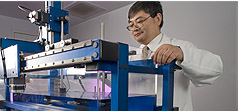Novel Ultrasound Contrast Agents
Development Of Polymer Microbubbles
We are developing and refining methods for synthesizing microbubbles made of biodegradable polymers. In collaboration with Dr. Wagner, we are attempting to develop a “library” of polymer microbubbles which are “tunable” to the specific need. This requires precision control of microbubble size, shell thickness and elasticity during the fabrication process. We have the capacity to perform acoustic characterization of the microbubble species to determine features such as harmonic response. In addition, we will have the unique capability to optically characterize the microbubble behavior in an acoustic field using a high speed digital camera (25 million frames per second). This dual capability will confer ability to optimize detection strategies for these microbubbles (for imaging purposes). Also, by understanding the specific behaviors of different microbubble species in an ultrasound field, we can prospectively design ultrasound delivery strategies for eliciting specific therapeutic effects. For example, ultrasound-induced microbubble destruction can be used for gene or drug delivery, whereas ultrasound-induced microbubble compression of cell membranes can be utilized for a different therapeutic application such as enhancement of drug uptake by cells. Optical characterization of such phenomena using our unique ultra-high speed imaging system will allow optimization and customization of the ultrasound/bubble protocol for the specific need.
Optimization Of Microbubble Adhesion Properties
Current targeting strategies typically employ attachment of maximum number of targeting ligands on to the microbubble surface to optimize adhesion to the target. It is difficult to empirically test every targeting ligand surface density to determine the effect, if any, of changing ligand density on adhesion under various flow conditions. Furthermore, if multi-targeting for more than one epitope is performed on a single microbubble platform, the optimal relative densities of each targeting ligand per microbubbles requires a rational basis for selection. To address the complex interplay among the many factors influencing microbubble kinetics and ultimately firm adhesion, we are pursuing computational modeling of adhesive dynamics of microbubbles in order to predict microbubble adhesion events resulting from alteration of relevant parameters in microbubble design, such as microbubble size, ligand density, target density, wall shear rate, etc. The model can then be used to prospectively design microbubbles that are optimized for adhesion to their molecular target. This work is being spearheaded by Dr. Tim Maul in collaboration with Dr. William Wagner.


